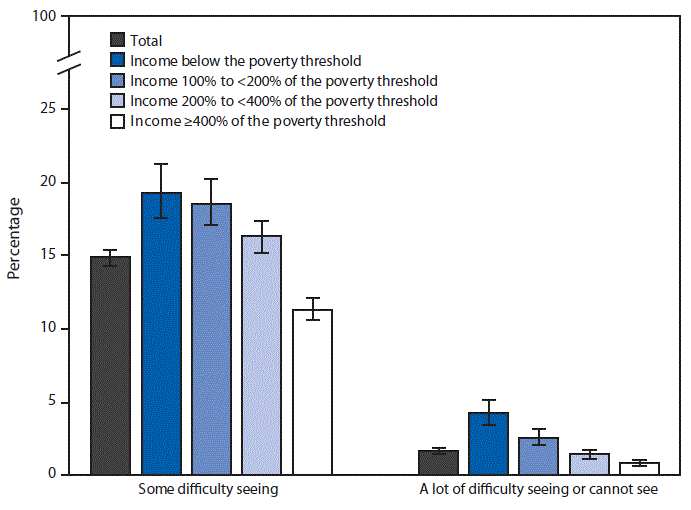QuickStats: Age-Adjusted Percentage* of Adults Aged ≥18 Years Who Have Difficulty Seeing Even When Wearing Glasses,† by Poverty Status§ — National Health Interview Survey, United States, 2018¶
Weekly / May 8, 2020 / 69(18);564

* With 95% confidence intervals indicated by error bars.
† Based on the response to survey question that asked “Do you have difficulty seeing, even when wearing glasses? Would you say no difficulty, some difficulty, a lot of difficulty, or are you unable to do this?”
§ Family income groups were defined based on family income as a percentage of the federal poverty threshold. Poverty thresholds, which are published by the U.S. Census Bureau, vary by family size and the number of children in the family. When missing, family income was imputed using multiple imputation methodology.
¶ Estimates are based on household interviews of a sample of the civilian, noninstitutionalized U.S. population, are shown for sample adults aged ≥18 years, and are age-adjusted using the projected 2000 U.S. population as the standard population and using four age groups: 18–44, 45–64, 65–74, and ≥75 years.
In 2018, 14.9% of adults aged ≥18 years had some difficulty seeing even when wearing glasses, and 1.6% had a lot of difficulty or could not see at all. The percentage of adults who had some difficulty seeing even when wearing glasses decreased as income increased, from 19.3% among those with income below the poverty threshold to 11.3% among those with income ≥400% of the poverty threshold. The percentage of adults who had a lot of difficulty or could not see at all also decreased as income increased, from 4.2% among those with income below the poverty threshold to 0.8% among those with income ≥400% of the poverty threshold.
Source: National Center for Health Statistics, National Health Interview Survey, 2018. https://www.cdc.gov/nchs/nhis.htm.
Reported by: Maria A. Villarroel, PhD, MVillarroel@cdc.gov, 301-458-4668; Debra L. Blackwell, PhD.
Suggested citation for this article: QuickStats: Age-Adjusted Percentage of Adults Aged ≥18 Years Who Have Difficulty Seeing Even When Wearing Glasses, by Poverty Status — National Health Interview Survey, United States, 2018. MMWR Morb Mortal Wkly Rep 2020;69:564. DOI: http://dx.doi.org/10.15585/mmwr.mm6918a4external icon.
MMWR and Morbidity and Mortality Weekly Report are service marks of the U.S. Department of Health and Human Services.
Use of trade names and commercial sources is for identification only and does not imply endorsement by the U.S. Department of
Health and Human Services.
References to non-CDC sites on the Internet are
provided as a service to MMWR readers and do not constitute or imply
endorsement of these organizations or their programs by CDC or the U.S.
Department of Health and Human Services. CDC is not responsible for the content
of pages found at these sites. URL addresses listed in MMWR were current as of
the date of publication.
All HTML versions of MMWR articles are generated from final proofs through an automated process. This conversion might result in character translation or format errors in the HTML version. Users are referred to the electronic PDF version (https://www.cdc.gov/mmwr) and/or the original MMWR paper copy for printable versions of official text, figures, and tables.
Questions or messages regarding errors in formatting should be addressed to mmwrq@cdc.gov.